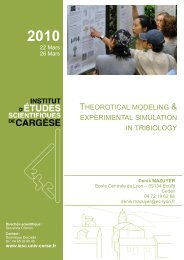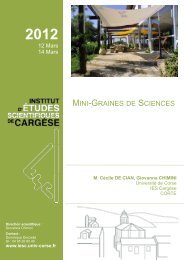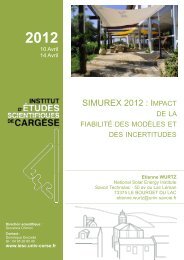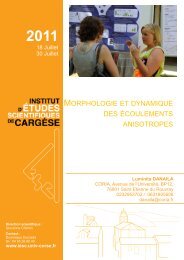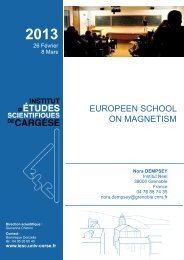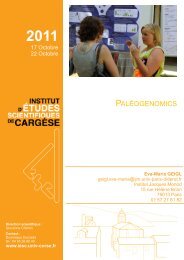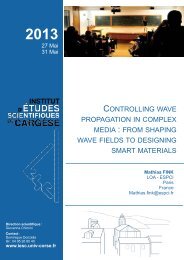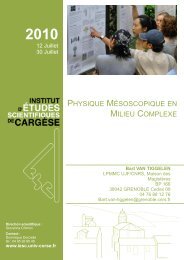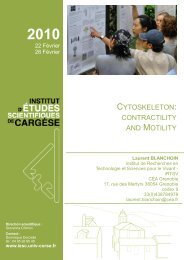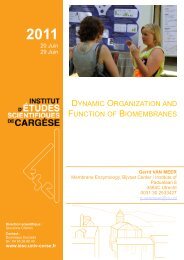nanoelectronics - Institut d'Études Scientifiques de Cargèse (IESC)
nanoelectronics - Institut d'Études Scientifiques de Cargèse (IESC)
nanoelectronics - Institut d'Études Scientifiques de Cargèse (IESC)
Create successful ePaper yourself
Turn your PDF publications into a flip-book with our unique Google optimized e-Paper software.
Posters<br />
Posters<br />
Ab-initio study of the thermopower of biphenyl-based single-molecule junctions<br />
M. Bürkle 1, 2 , L. A. Zotti 3 , J. K. Viljas 4, 5 , D. Vonlanthen 6 , A. Mishchenko 7<br />
T. Wandlowski 7 M. Mayor 2, 6, 8 G. Schön 1, 2, 8 1, 2, 9<br />
and F. Pauly<br />
1<br />
<strong>Institut</strong>e of Theoretical Solid State Physics, Karlsruhe <strong>Institut</strong>e of Technology, D-76131<br />
Karlsruhe, Germany<br />
2<br />
DFG Center for Functional Nanostructures, Karlsruhe <strong>Institut</strong>e of Technology, D-76131<br />
Karlsruhe, Germany<br />
3<br />
Departamento <strong>de</strong> Física Teórica <strong>de</strong> la Materia Con<strong>de</strong>nsada,<br />
Universidad Autónoma <strong>de</strong> Madrid, E-28049 Madrid, Spain<br />
4<br />
Low Temperature Laboratory, Aalto University, P.O. Box 15100, FIN-00076 Aalto, Finland<br />
5<br />
Department of Physics, P.O. Box 3000, FIN-90014 University of Oulu, Finland<br />
6<br />
Department of Chemistry, University of Basel, CH-4056 Basel, Switzerland<br />
7<br />
Department of Chemistry and Biochemistry, University of Bern, CH-3012 Bern, Switzerland<br />
8<br />
<strong>Institut</strong>e for Nanotechnology, Karlsruhe <strong>Institut</strong>e of Technology, D-76344 Eggenstein-<br />
Leopoldshafen, Germany<br />
9<br />
Molecular Foundry, Lawrence Berkeley National Laboratory, Berkeley, California 94720<br />
By employing ab initio electronic-structure calculations combined with the nonequilibrium<br />
Green's function technique, we study the <strong>de</strong>pen<strong>de</strong>nce of the thermopower Q on the<br />
conformation in biphenyl-based single-molecule junctions. For the series of experimentally<br />
available biphenyl molecules, alkyl si<strong>de</strong> chains allow us to gradually adjust the torsion angle<br />
between the two phenyl rings from 0 ° to 90 ° and to control in this way the <strong>de</strong>gree of π-<br />
electron conjugation. Studying different anchoring groups and binding positions, our theory<br />
predicts that the absolute values of the thermopower <strong>de</strong>crease slightly towards larger torsion<br />
angles, following an a+bcos2 <strong>de</strong>pen<strong>de</strong>nce. The anchoring group <strong>de</strong>termines the sign of Q<br />
and a,b simultaneously. Sulfur and amine groups give rise to Q,a,b>0, while for cyano,<br />
Q,a,b



